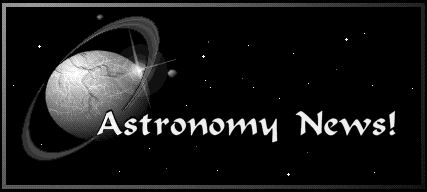
In this short little Web page, we will provide some of the latest news
relating to astronomy and space exploration. Most of the material found
here is available elsewhere on the Internet, but we thought that it would
be helpful to provide the information all in one place. You can obtain more
information on a given topic by clicking on the date of its release.
Links to elsewhere
- This Month in Space History
- Astronomy Picture of the Day
Spacecraft news
- May 3, 1996
- Galileo discovers that Io has a giant iron core
- March 19, 1996
- Further analysis of Galileo data yields that Jupiter's composition is
closer to that of the Sun that originally thought.
- March 15, 1996
- Galileo Perijove Raise Maneuver successful!
- March 13, 1996
- Galileo mission overview chart
- January 22, 1996
- The data from Galileo's atmospheric probe is now in. It made a great
deal of important discoveries, including the facts that Jupiter is drier,
windier, and has less lightning than originally thought.
- November 1, 1995
- The Voyager 1 and 2 spacecraft remain healthy. Barring malfunctions, it is
expected that their power source will continue to keep these interplanetary
travellers alive until at least the year 2025.
- October 1, 1995
- The spacecraft Ulysses has completed its primary role in exploring the
polar regions of the Sun.
Solar System Objects
- March 13, 1996
- The Hubble Space Telescope
obtains the first direct images of Pluto! Hubble has imaged nearly the entire
surface of this distant planet in late June and early July 1994. The pictures were
released to the general public on March 7, 1996.
- March 2, 1996
- Comet Hyakutake seems destined to be the brightest comet since Comet West
in 1976. It will be at its most impressive on March 25, 1996!
- October 5, 1995
- Chaos theory is alive and well in our solar system. Two radio astronomers
have discovered that the asteroid known as 4179 Toutatis is tumbling irregularly
instead of spinning about an axis as do most other members of the Sun's family.
Elsewhere
- January 17, 1996
- Two planets have been discovered orbiting around sunlike stars, with
surface temperatures believed to allow liquid water to exist.
- October 21, 1995
- A planet has been discovered by Swiss astronomers, orbiting around a
sunlike star known as 51 Pegasi.
- November 2, 1995
- Astronomers have used the Hubble Space Telescope to show newly-created stars
in the process of emerging from their parent nebulae. These "evaporating gaseous
globules", or EGGs, are located 7000 light years away in the Eagle nebula.
Go back to Syzygy Home Page.

